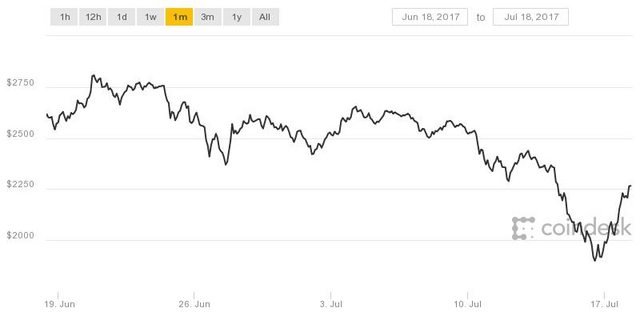Is Bitcoin Plunge Running Out of Steam?
Over the weekend, the price of Bitcoin had a steep plunge, breaking the $2000 psychological level and touching even the $1800 price mark. All that was occasioned by the fear, uncertainty and doubt - FUD, of what 1st of August portends for the community. It was near pathetic and not just Bitcoin but just about every other cryptocurrency became engulfed by bear markets, attesting to the fact that whatever impacts Bitcoin positively or negatively, goes to impact the entire digital currencies.
However Bitcoin price have bounced back appreciably today amid news that a hard fork of the world's first truly decentralized digital currency would be avoided. As I write this, Bitcoin is trading at $2367.50, a recovery of 5.49% at CoinDesk. Report has it that signalling of sewit2x have already started with 60% of the 144 blocks mined in the last 24 hours signaling support for Segwit2x through BIP91. If a total of 80% of miners back this update over the next 56 hours, the new code will lock-in, moving Bitcoin away from a split. Some bitcoiners are excited by this seeming progress for a resolution to the scaling debate, which is why the price of Bitcoin is rallying again. The news came from CoinDesk, which is a subsidiary of the Digital Currency Group which helped organize the Segwit2x agreement.
What exactly does (Bitcoin Improvement Proposal)91 - BIP91, mean for the network? As the first part of the Segwit2x scaling plan, BIP91 does two things:
1. It makes it significantly easier for the network to adopt Segregated Witness (Segwit), a backward compatible upgrade that fixes transaction malleability and clears the path for off-chain solutions like Lightning Network.
2. If activated by July 31, BIP 91 supersedes BIP 148, a proposal that poses a risk of causing the network to split.
Preambles:
SegWit2x was introduced during CoinDesk's Consensus 2017 conference in May. Based on a fork of the Bitcoin Core software client called BTC1, Segwit2x seeks to both implement SegWit and raise the block size.About a month later, as a response to that, BitmainWarranty engineer, James Hilliard introduced BIP 91 as a way to implement Segwit quickly and safely, without causing a fork in the network. He specifically developed the proposal with two other active proposals for scaling bitcoin in mind. These include:
- BIP 141: Introduced in November 2016, BIP 141 is the original plan for activating Segwit.
- BIP 148: Released in March, BIP 148 was developed as a way to push through BIP 141 via a user-activated soft fork (UASF).
But, more importantly, BIP 91 was proposed as an alternative to having to completely redeploy BIP 141, a task that would have been technically infeasible, given that BIP 141 does not expire until mid-November.So, to get around that, BIP 91 employs a clever trick. Rather than change the Segwit activation code path, it simply adds an additional rule to enforce BIP 141 mandatory signaling.As such, BIP 91 uses the same version bits soft fork deployment as BIP 141, but with a few key differences:
- Miners signal with "bit 4," as opposed to "bit 1"
- Activation only requires 80% as opposed to 95% of hash power support
- The activation window is 336 blocks, as opposed to 2,016.
So, once that 80% threshold is reached, BIP 91 locks in, and another 336 blocks later, it activates.At that point, BIP 141 is enforced using the same technique as BIP 148:
- Miners begin signaling with "bit 1"
- Any blocks that do not signal with "bit 1" will be blocked from the network.
As long as 51% of miners (by hash power) enforce the mandatory signalling, the chain will not split. And since 80% already supported the activation, chances are good that that will not be a problem. As an additional incentive, miners who do not signal run the risk of losing their 12.5 bitcoin block reward.
BIP 91 was also a recognition of the realities of the scaling debate.Namely, the fact that, nearly a year down the road, BIP 141 still has not gained traction with miners. While BIP 141 requires a 95% miner support (by hash power), the figure has remained stuck at around 30%, though recently it increased to 45%.
The proposal that has had the biggest impact on BIP 91's design is BIP 148, the so-called UASF discussed above. In many ways, BIP 91 can be read as an effort to "deactivate" the BIP 148 proposal, thus removing the potential to create two rival Bitcoin blockchains, each with competing assets. To resolve that issue, Hilliard proposed that BIP 91 should activate before the end of July and BIP 148's August 1st deadline. Miners today are signaling their support for BIP91 early because of the perceived need to avoid the split BIP 148 could create and speculations that a successful UASF would reduce their control over network changes. For now, your best bet is to watch the next 336 -block period. Should 80% of blocks signal for BIP 91 within a 56-hour period, Segwit will lock-in, thus setting the stage for the next phase of Segwit2x this autumn.
What're your views?

I am your follower, and i saw your posts. you are doing good:) @ronaldmcatee
hi vic, i would like to get my hacked account back... steemdice1-3 mixing looks cool, but if you need money, we can find a better place for your talent :)
Congratulations @victorycoin! You have received a personal award!
Click on the badge to view your own Board of Honor on SteemitBoard.
Congratulations @victorycoin! You received a personal award!
Click here to view your Board of Honor
Do not miss the last post from @steemitboard:
Congratulations @victorycoin! You received a personal award!
You can view your badges on your Steem Board and compare to others on the Steem Ranking
Vote for @Steemitboard as a witness to get one more award and increased upvotes!